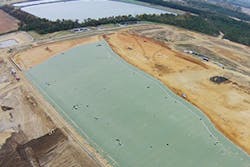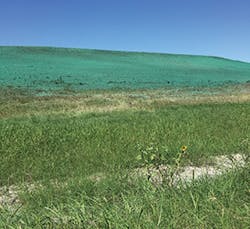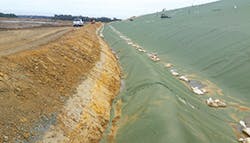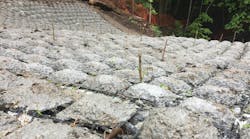About Landfill Caps
EPA maintains strict guidelines with which municipal solid waste landfills must comply once a landfill has reached its maximum capacity, setting in motion its closure.
One of the requirements is that landfill owners must continue to monitor and maintain the landfill, typically for 30 years, to ensure that waste material doesn’t leave the site and pollute the surrounding environment.
Among the post-closure requirements are that landfill operators are responsible for maintaining the integrity and effectiveness of the following four elements:
- A final cover system
- Leachate (contaminated liquid draining from the landfill) collection system
- Groundwater monitoring
- Methane gas monitoring
EPA states, “The final cover system must consist of an infiltration layer of at least 18 inches of earthen material covered by an erosion layer of at least 6 inches of earthen material that is capable of sustaining native plant growth.
An alternative cover design may be used as long as it provides equivalent protection against infiltration and erosion.”
Owners have a variety of methods of capping the landfill, and in many cases are quite creative in creating parks or other public uses for the area once the landfill is closed. However, they are further subject to the requirement that “Any use of the land during this period must not disturb the integrity or operation of any of the waste containment systems or monitoring systems.”
John Bolton, business director for Tensar Engineered Structures, explains a typical landfill capping system:
“With municipal solid waste, the capping is typically done with soil veneer covers. Your cap layer typically starts with a liner. On top of that, you would typically have some type of drainage composite, but not always. Then you will normally have a certain veneer of soil, usually two feet. Erosion control products can be used to help us establish vegetation on top of that.”
One of the concerns he notes, however, is that the weight of a soil veneer cover that is placed over a lining system can cause a sliding failure, especially for soil veneer covers used on relatively steep slopes.
“In such cases,” he says, “we can use geogrid in those soil veneer covers.
“The veneer cover can use geogrid right where the liner and the soil meet. As you can imagine, some of these liners are very smooth, and they have no texture. The soil might want to slide down off of that liner. So the geogrid layer would be placed directly on top of the liner. Because it has apertures, it interlocks directly with the soil and holds it in place. So that’s where the grid would be used in a capping system.
“Normally the cap system includes two feet of soil, and then a vegetated layer, because they don’t want a slope to be exposed to massive rain events; that’s when erosion will happen. The objective of capping landfills is to keep water out of the system and to let the natural process inside the encapsulated area take place.”
That natural process includes settlement of waste material over time within the landfill.
“There will be settlement,” says Bolton, “and they work that into the grading plan, so they dissipate a certain amount of settlement. It’s pretty much defined now what municipal solid waste does, in terms of compaction over time. So there will be a grading plan for that trash. Also, the weight of the cover lining system helps with that consolidation.”
On a working landfill, he points out, “Every day, they have to put a cover on top, so it’s not exposed. It’s called a daily cover. With all this work, there’s quite a bit of consolidation that takes place. In fact, I would guess that a majority of the consolidation happens while the landfill material is being placed, and while the daily cover is placed on and taken off, working with the trash.
“But the landfill plan will specify the settlement tolerances for the cap. At the end of the day, there may be pockets where things settle out more than anticipated, but for the most part, they do a good job at controlling this. The whole lining and capping system is to keep the leachate out of the groundwater.”
Repairing a Failed Seeding Operation
The Robstown, TX, landfill, owned by US Ecology, opened in the 1970s and is one of a handful of landfills nationwide that accepts hazardous waste. Located in rather remote open farm country west of Corpus Christi, it also takes in a variety of industrial waste products, including petrochemicals, refinery sludge, agricultural chemicals, and pharmaceuticals.
It’s a large, active site, but a small 35-acre portion has been capped within the past couple of years. Wayne Woodward is General Manager of TeRo Enterprises LLC, with offices in both Oklahoma and Texas, and he worked on this 35-acre site.
He notes that US Ecology had previously seeded about 20 acres of this cap, but the vegetation failed because of the silty soil present in this coastal location.
“I wasn’t involved with that part of the project at the time,” says Woodward. “They didn’t have a failure on the cap, they had a failure with the seeding. But this time, we used Profile Products amendments on it, and they added some topsoil to it as well. We always use aquagels as well, because of the dry soil. I also used a 16-45-7 fertilizer, which I’ve had good luck with.
“We then sprayed it with Profile ProMatrix Engineered Fiber Matrix at a rate of 3,500 pounds per acre, as a cover. We used a mix of seeds, including Bermuda grass.
“When it’s all said and done, and the first germination is complete, I’m going to go back, and I’ll fertilize it with 400 pounds per acre of triple-15. That’ll be a tractor application, and that will give it life again.
“It doesn’t get any water, except for what rains on it. They try to water it a little bit with a water truck, but that’s sometimes more hazardous than it is healthy.”
The ProMatrix product is a biodegradable bonded fiber matrix composed of recycled wood fibers and interlocking man-made crimped fibers that increase the strength and durability of the matrix. Within 24–48 hours of application, the ProMatrix material is cured and allows for rapid germination. Its anticipated functional life is up to 12 months.
“Before the application of ProMatrix,” says Woodward, “they put their soil and compaction into it. I believe they put down six inches of topsoil that they hauled in—that’s a normal amount.
“Most of the time, landfills have access to topsoil. It may not be what we really consider to be a good topsoil, but normally they’ll have a farm nearby, or someone who will haul dirt in. Often, the landfills are pretty restrictive about what they’ll buy when it comes to topsoil.
“Landfill owners tend to be really good about hydraulic blankets and what you want to spray for seed, and this should be a good cover. I haven’t seen much come up yet, because it hasn’t had much time and it’s been unseasonably warm. This time of year, we usually get wheat, rye, and oats coming up pretty quickly in the cooler weather. But it needs to be in the 70s, and we haven’t seen a lot of that. The daytime highs have been in the mid-90s.
“So it’s been too hot for that seed, and it’s too dry for the Bermuda seed to get started real well. Right now, though, we’ve got rain, and we’ve got cool weather, so that should help. In fact, we may be getting a lot of rain, so that will put the ProMatrix to the test.”
Woodward explains that very little maintenance will be required on the site.
“After the fertilizer is applied, which usually is done about 30 days after the first application, and after germination, it won’t require anything except mowing. They’ll mow it with their big mowers, where they can. But the rest of it will be low-to-the-ground growth. Some clump grasses are in there, but most of what I plant is low to the ground, like Bermuda.
Robstown, TX, landfill
“In that climate down there, it should get plenty of rain. It’s a coastal area, so we should be able to get two or three seasons of good rain.
“From time to time, and depending on where it is and how much the company wants it to stay green and pretty—whether they want it to look like Texas hill country or they want it to look green—they may fertilize it once a year. They may just broadcast it.”
He notes that the quality and nature of the soil naturally impacts how he proceeds. “The soil down in that south Texas area is either real dark gumbo clay soil, or it’s real sandy, or a mixture of those two. That sandy area has a hard time holding nutrients. So when you’ve got a bunch of new seed in there, the fertilizers that I use are what we call starter fertilizers. They release all their nitrogen and phosphates right off the bat. It’s just a giant blast that we use to germinate quickly and get a stand of grass, but then it’s gone.
“It doesn’t stay in the ground. But then we try to come back with a granular fertilizer, and provide it with some nitrogen and some food, so it can continue to grow. This is a time-release product, so it will stay in the ground a long time.”
The seed he used was a mixture of Bermuda, oats, rye, kleingrass, and a combination of native Texas seed.
In one area of the landfill, there have been chronic problems with flooding during heavy rains. “When it rains, it rains hard. It can drain fast in that area,” notes Woodward.
As a result, US Ecology has expressed interest in directing water flow off the landfill slope to a specific location.
“We’re talking to them about some gabion baskets in one section to divert water into a channel and get the water all off to one side. That’s in process, but it’s not done yet.”
Woodward adds that although the bulk of the capped landfill was treated with ProMatrix, a smaller test section, comprising about 20,000 square feet, was handled differently. On this portion he applied ProGanics and Flexterra, two other Profile Products’ materials.
“These add a lot of microbials and act somewhat as a soil replacement,” he says. “This material is more expensive than the ProMatrix, but we wanted the landfill owners to see how they function, in case they decide they want to go this direction in the future.”
According to Woodward, the job site was conducive to a successful completion.
“US Ecology had a well-laid-out plan, and there was water available onsite. It was rainwater that we pumped from ponds. US Ecology was extremely helpful, and it wasn’t particularly hard to get to. We have been able to get about three or four acres a day done.”
Lower anchor trench
A Different Kind of Cover
Located on the eastern shore of Maryland’s Chesapeake Bay, the Midshore Regional Solid Waste System consists of several facilities to serve the region’s landfill needs for a span of 80 years. Approximately 140,000 residents live in the area.
Owned by Maryland Environmental Services (MES), the first of these landfills, Midshore I, was constructed in Talbot County, MD, and began operations in 1991, continuing until December 31, 2010.
The second facility, Midshore II, opened full-scale operations in January 2011 in nearby Caroline County and is intended to operate until the end of 2030. Two additional facilities are planned.
Although Midshore I is now closed, MES continues to monitor the landfill for gas extraction and also monitors nearby groundwater and wells. Leachate is collected and transferred to Midshore II. This post-closure monitoring is required for a period of 30 years.






